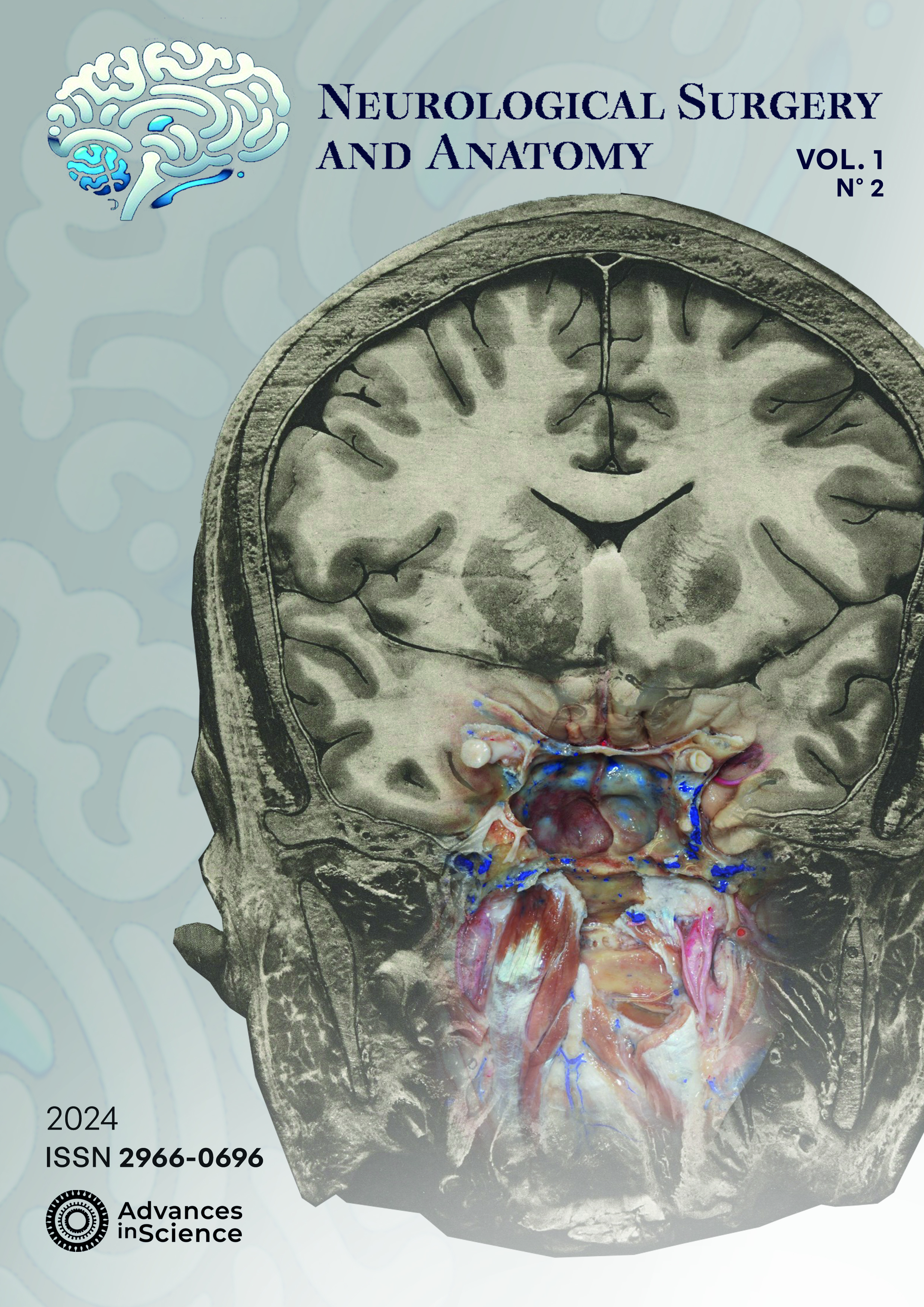Historical skull illustrations: Parietal foramen
Views: 157DOI:
https://doi.org/10.37085/nsa.2024.16Keywords:
Anatomy, Neurosurgery, Parietal foramen, History, Skull, Antonio de PeredaAbstract
Introduction
Anatomical illustration has progressed historically to become a means of documentation. The representation of a particular anatomical structure in a drawing/painting meant the artist/anatomist was aware of its presence, position and relation to surrounding structures and can also be used as a primer for tracking the knowledge about such structure. Despite the detailed historical depictions of the skull, the parietal emissary foramen often went unillustrated.
Objective
This study focuses on the parietal foramen and its historical depiction.
Methods
It perused artistic illustrations of the skull to establish by whom and when this foramen was displayed.
Results
Located in the posterior part of the parietal bone, the parietal foramen allows passage for the parietal emissary vein and other structures. Its presence varies among populations, which may explain its omission in some anatomical works. However, artists like Antonio de Pereda and anatomists like Bernhard Siegfried Albinus and John Bell did illustrate it. As other emissary foramina, the parietal emissary foramen has a role in helping regulate intracranial pressure and brain temperature. Its significance has increased throughout human evolution, particularly with the development of bipedalism and larger brain volumes. The foramen may also function as a path in the spread of infection and/or tumors. Recent studies using CT scans have emphasized the importance of recognizing the parietal foramen in imaging and surgical planning.
Conclusion
This paper helps uncover part of the history of neuroanatomical illustration pertaining to the depiction of the parietal foramen and highlights its clinical and surgical importance.
References
Blits KC. Aristotle: Form, function, and comparative anatomy. Anat Rec. 1999 Apr 15;257(2):58–63. Doi:10.1002/(SICI)1097-0185(19990415)257:2<58::AID-AR6>3.0.CO;2-I
Ghosh SK. Evolution of illustrations in anatomy: A study from the classical period in Europe to modern times. Anat Sci Educ. 2015 Mar 22;8(2):175–88. Doi: 10.1002/ase.1479
Olry R. Medieval neuroanatomy: The text of Mondino Dei Luzzi and the plates of guido da Vigevano*. J Hist Neurosci. 1997 Aug;6(2):113–23. Doi: 10.1080/09647049709525696
Missinne SJ. The oldest anatomical handmade skull of the world c. 1508: ‘The ugliness of growing old’ attributed to Leonardo da Vinci. Wiener Medizinische Wochenschrift. 2014 Jun 23;164(11–12):205–12. Doi: 10.1007/s10354-014-0282-0
Hast MH, Garrison DH. Vesalius on the variability of the human skull: Book I Chapter V ofDe humani corporis fabrica. Clinical Anatomy. 2000;13(5):311–20. Doi: 10.1002/1098-2353(2000)13:5<311::AID-CA1>3.0.CO;2-X
Murlimanju B V., Saralaya V V., Somesh MS, Prabhu L V., Krishnamurthy A, Chettiar GK, et al. Morphology and topography of the parietal emissary foramina in South Indians: an anatomical study. Anat Cell Biol. 2015;48(4):292. Doi: 10.5115/acb.2015.48.4.292
de Souza Ferreira MR, Galvão APO, de Queiroz Lima PTMB, de Queiroz Lima AMB, Magalhães CP, Valença MM. The parietal foramen anatomy: studies using dry skulls, cadaver and in vivo MRI. Surgical and Radiologic Anatomy. 2021 Jul 5;43(7):1159–68. Doi: 10.1007/s00276-020-02650-0
Yoshioka N, Rhoton AL, Abe H. Scalp to Meningeal Arterial Anastomosis in the Parietal Foramen. Operative Neurosurgery. 2006 Feb 1;58(suppl_1):ONS-123-ONS-126. Doi: 10.1227/01.NEU.0000193516.46104.27
Currarino G. Normal variants and congenital anomalies in the region of the obelion. American Journal of Roentgenology. 1976 Sep 1;127(3):487–94. Doi: 10.2214/ajr.127.3.487
Wysocki J, Reymond J, Skarzyński H, Wróbel B. The size of selected human skull foramina in relation to skull capacity. Folia Morphol (Warsz). 2006 Nov;65(4):301–8.
Shmarhalov A, Vovk O, Ikramov V, Acharya Y, Vovk O. Anatomical variations of the parietal foramen and its relations to the calvarial landmarks: a cross-sectional cadaveric study. Wiadomości Lekarskie. 2022 Jul;75(7):1648–52. Doi: 10.36740/WLek202207106
Tsutsumi S, Nonaka S, Ono H, Yasumoto Y. The extracranial to intracranial anastomotic channel through the parietal foramen: delineation with magnetic resonance imaging. Surgical and Radiologic Anatomy. 2016 May 24;38(4):455–9. Doi: 10.1007/s00276-015-1579-4
Penteado C V, Santo Neto H. The number and location of the parietal foramen in human skulls. Anat Anz. 1985;158(1):39–41.
Naidoo J, Luckrajh JS, Lazarus L. Parietal foramen: incidence and topography. Folia Morphol (Warsz). 2021 Dec 2;80(4):980–4. Doi: 10.5603/FM.a2020.0140
Liu D, Yang H, Wu Jua, Li JH, Li YK. Anatomical observation and significance of the parietal foramen in Chinese adults. Folia Morphol (Warsz). 2022 Dec 8;81(4):998–1004. Doi: 10.5603/FM.a2021.0106
Kitazawa M. Parietal foramen in modern Japanese calvaria, its frequency and location. Journal of Nippon Medical School. 1987;54(3):229–43. Doi: 10.1272/jnms1923.54.229
Al-Shuaili A, Al-Ajmi E, Mogali SR, Al-Qasmi S, Al-Mufargi Y, Kariyattil R, et al. Computed-tomography evaluation of parietal foramen topography in adults: a retrospective analysis. Surgical and Radiologic Anatomy. 2024 Jan 27;46(3):263–70. Doi: 10.1007/s00276-023-03284-8
Bell J, Charles Bell. The anatomy and physiology of the human body. Containing the anatomy of the bones, muscles, and joints; and the heart and arteries. Vol. 3. New york: Collins & co; 1822. 1–394 p.
Falk D. Evolution of cranial blood drainage in hominids: Enlarged occipital/marginal sinuses and emissary foramina. Am J Phys Anthropol. 1986 Jul 7;70(3):311–24. Doi: 10.1002/ajpa.1330700306
Nawashiro H, Nawashiro T, Nawashiro A. Subcutaneous Extension of Parasagittal Atypical Meningioma Through Parietal Foramen. World Neurosurg. 2019 May;125:104–5. Doi: 10.1016/j.wneu.2019.01.185









